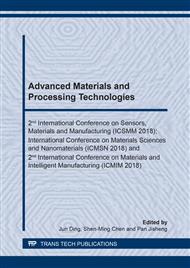[1]
K. Ali, S.A. Khan, and M.Z.M. Jafri: Effect of double layer (SiO2∕TiO2) anti-reflective coating on silicon solar cells. Int. J. Electrochem. Sci. 9 (Oct. 2014), 7865-7874.
Google Scholar
[2]
A.A. Solovyev, S.V. Rabotkin, and N.F. Kovsharov: Polymer films with multilayer low-E coatings. Mater. Sci. Semicond. Process. 38 (Oct. 2015), 373-380.
DOI: 10.1016/j.mssp.2015.02.051
Google Scholar
[3]
M. Ylilammi, and T. Ranta-aho: Optical determination of the film thicknesses in multilayer thin film structures. Thin Solid Films 232 (Sep. 1993), 56-62.
DOI: 10.1016/0040-6090(93)90762-e
Google Scholar
[4]
J.C. Manifacier, J. Gasiot, and J.P. Fillard: A simple method for the determination of the optical constants n, k and the thickness of a weakly absorbing thin film. J. Phys. E: Sci. Instrum. 9, 11 (1976), 1002-1004.
DOI: 10.1088/0022-3735/9/11/032
Google Scholar
[5]
Y.D. Pyung, M. Chang, and E. Kim, et al: Modeling and optimization of the growth rate for ZnO thin films using neural networks and genetic algorithms. Expert Syst. Appl. 36, 2 (Mar. 2009), 4061-4066.
DOI: 10.1016/j.eswa.2008.03.010
Google Scholar
[6]
A. Khorasani, A. Kootsookos, and P. Saadatkia: Artificial Neural Network Modelling on TiN Coating Parameters in Sputtering Process. In 3rd International and 12th National Conference on Manufacturing Engineering (Tehran, Iran, December 27 - 29, 2011). 1-6.
Google Scholar
[7]
H. Wang, S.J. Hsieh, and A. Stockton: Evaluating the performance of artificial neural networks for estimating the nonmetallic coating thicknesses with time-resolved thermography. Opt. Eng. 53, 8 (Aug. 2014), 083102.
DOI: 10.1117/1.oe.53.8.083102
Google Scholar
[8]
H.A. Macleod, in: Thin-Film Optical Filters, 4th ed. CPC Press, Boca Raton, Florida, 13-71. (2010).
Google Scholar
[9]
J.A.K. Suykens, J.P.L. Vandewalle, and B.L.R. Moor: Artificial neural networks: architectures and learning rules. In Artificial Neural Networks for Modelling and Control of Non-Linear Systems. Springer Science + Business Media, Dordrecht, 19-35.
DOI: 10.1007/978-1-4757-2493-6_2
Google Scholar
[10]
T.D. Wu, J.S. Chen, and C.P. Tseng, et al: Applying theoretical spectra to artificial neural networks for real-time estimation of thin film thickness. Opt. Eng. 55, 12 (Dec. 2016).
DOI: 10.1117/1.oe.55.12.125106
Google Scholar
[11]
P.G. Benardos, and G.C. Vosniakos: Optimizing feedforward artificial neural network architecture. Eng. Appl. Artif. Intel. 20, 3 (Apr. 2007), 365-382.
DOI: 10.1016/j.engappai.2006.06.005
Google Scholar


